Cusco, the Imperial City, is famous not only for its majestic Inca architecture and enchanting history but also for its vibrant religious festivals. Holy Week is one of the most moving and authentic celebrations, where Catholic fervor blends with ancient Andean traditions.
If you plan to visit Cusco during this time, prepare for a unique experience filled with processions, millennia-old rituals, and contagious devotion. Below, we detail how Holy Week in Cusco unfolds so you don’t miss a moment.
- Cusco Dressed in Faith: Experiencing Peru’s Most Authentic Holy Week
- Palm Sunday in Cusco: The Start of the Sacred Pilgrimage
- Holy Monday in Cusco: The Majestic Procession of the “Taytacha de los Temblores”
- Holy Thursday: Where Faith & Ancient Traditions Collide in the Heart of the Andes
- Good Friday 2025: Sacred Journeys & Flavors of Faith.
- Holy Saturday in Cusco: A Night of Fire, Faith, and & Rebirth
- Easter Sunday in Cusco: The Grand Celebration of Life
- Conclusion:
- You might also like…
Cusco Dressed in Faith: Experiencing Peru’s Most Authentic Holy Week
Ready to immerse yourself in Cusco’s vibrant energy? The UNESCO World Heritage Site isn’t just the historic capital of the Inca Empire; it’s also the stage for unique celebrations blending tradition, culture, and deep-rooted devotion.
Join us on this day-by-day journey as we explore the rituals, colors, flavors, and emotions that make Cusco an unforgettable destination during Holy Week.
Palm Sunday in Cusco: The Start of the Sacred Pilgrimage
2025 Date: April 13
Holy Week begins with Palm Sunday, commemorating Jesus’s triumphant entry into Jerusalem. In Cusco, this day carries a special Andean touch.
- Blessing of the Palms: Devotees carry handwoven olive branches and palm fronds for the priest to bless during the principal Mass at Cusco Cathedral and other local parishes
- Procession of the “Señor del Triunfo”: An image of Christ on a donkey parades through the streets, reenacting the biblical passage.
- Floral Carpets: Streets come alive with ephemeral designs made of flower petals, creating a sacred path for processions.
Did you know? Many families keep the blessed palms in their homes as spiritual protection throughout the year.
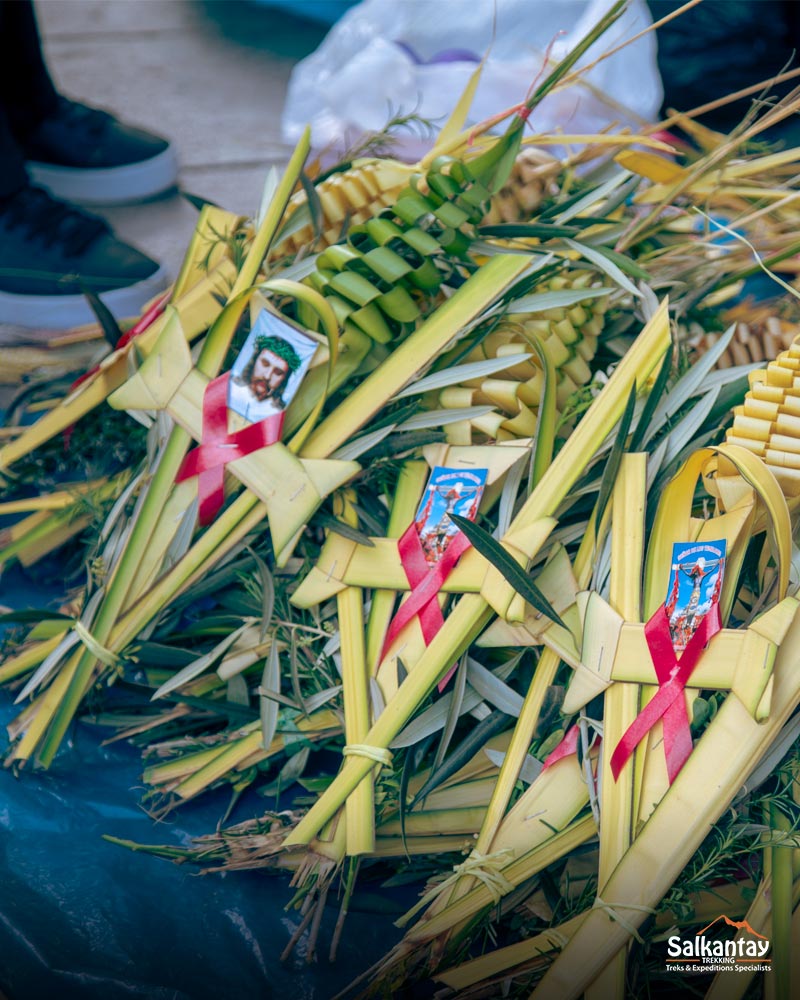
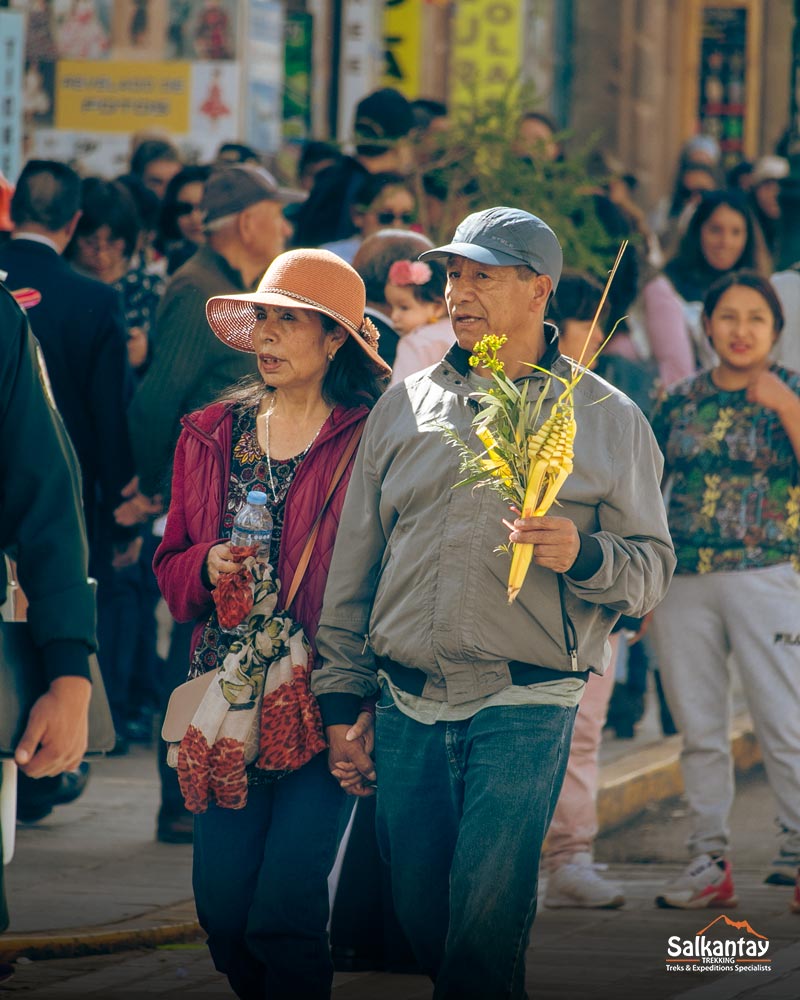
Holy Monday in Cusco: The Majestic Procession of the “Taytacha de los Temblores”
2025 Date: April 14
The Sworn Patron of Cusco: A Legacy of Faith and Protection
Holy Monday in Cusco is no ordinary day. The Imperial City dons its most reverent spirit to honor the “Taytacha de los Temblores” a venerated image of the Crucified Christ, proclaimed as the Sworn Patron of Cusco.
History and Legend: The Protector Against Earthquakes
- Colonial Origins: The revered statue of the “Lord of the Earthquakes” arrived in Cusco in the 16th century as a gift from King Charles V of Spain.
- The Miracle of 1650: When a devastating earthquake struck Cusco in 1650, tradition holds that the Taytacha halted the destruction as devotees paraded his image through the streets in a desperate procession. Since then, the people of Cusco have revered him as the city’s divine guardian.
- Proclaimed Sworn Patron: In 1741, Cusco’s City Council officially declared him the Patron of the City, cementing his role in both religious devotion and cultural identity.
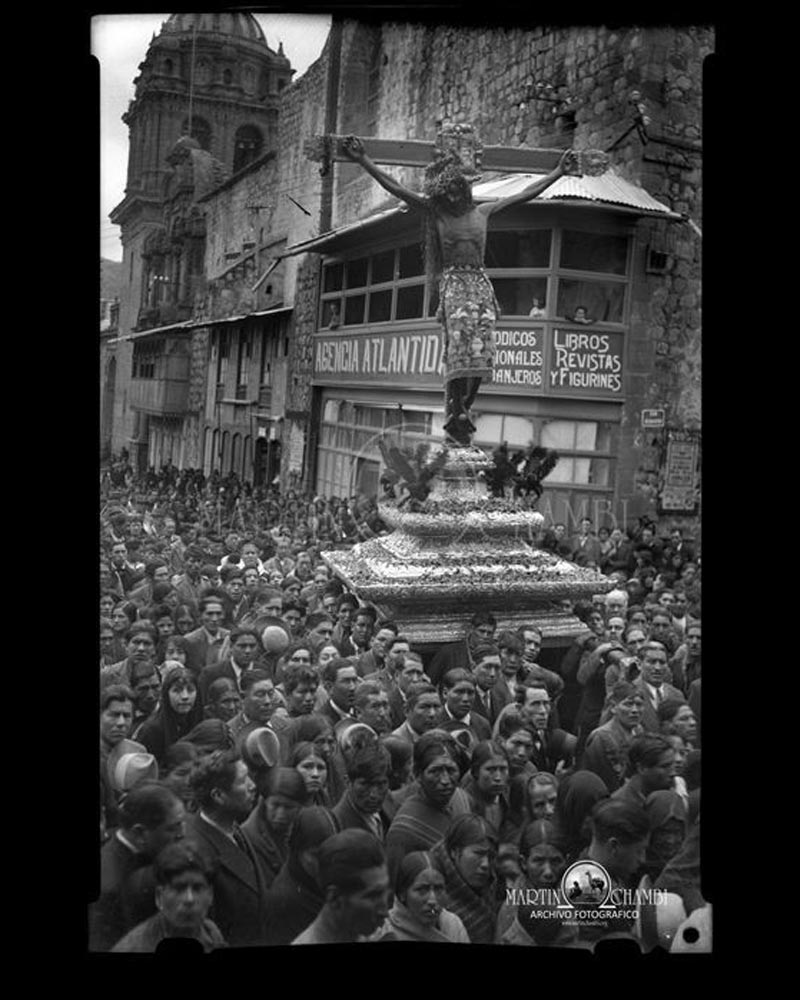
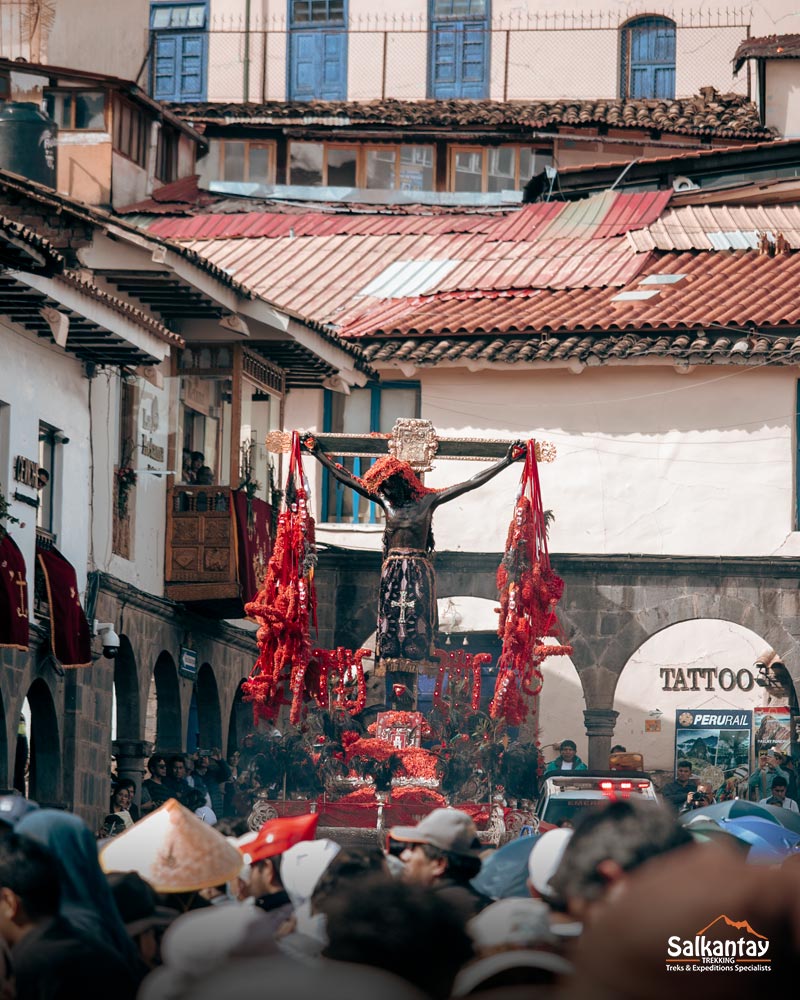
Holy Monday Procession: A Spectacle of Faith and Color
Every year, thousands of devotees and travelers flood the streets of Cusco to witness one of Peru’s most moving religious processions.
- The revered “Taytacha” statue is carried on a wooden platform by faithful clad in red cloaks, a color symbolizing Christ’s passion, sacred authority, and the powerful blend of Andean and Catholic traditions.
- Rain of Ñukch’u Flowers: Worshippers toss these sacred red blossoms in the statue’s path, creating a striking “river of blood” that is rich in spiritual symbolism.
- Bilingual Hymns: The cobblestone streets echo with devotional songs in Quechua and Spanish, merging Andean spirituality with Catholic tradition.
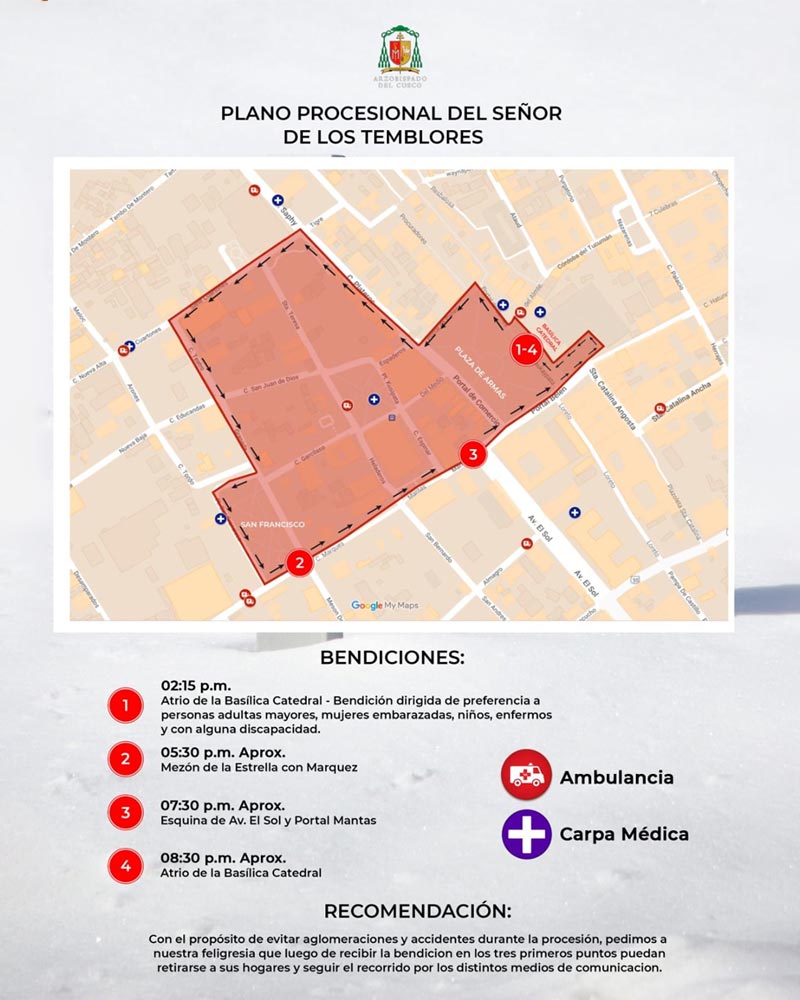
Best Spots to Experience the Holy Monday Procession in Cusco
Plaza de Armas (Main Square) – Best Views
- LIMO Peruvian Nikkei
- Address: Portal de Carnes 236, 2nd floorCuisine: Nikkei cuisine (Peruvian-Japanese fusion), ceviche, pisco sour with plaza views
- Hanz Craft Beer & Burger
- Address: Portal de Carnes 216, Plaza de armas.
- Cuisine: Besides offering international and fusion cuisine, the restaurant serves specialty craft beers and signature cocktails.
- Fusión Andina
- Address: Portal de Carnes 260.
- Comida: A contemporary take on Andean fusion, highlighting alpaca, quinoa, and reinvented ancestral flavors.
- La Retama
- Address: Portal de Panes 123, Plaza de Armas.
- Cuisine: Chefs serve traditional Peruvian flavors like lomo saltado and rocoto relleno with ancestral pride.
- Morena Peruvian Kitchen
- Address: Portal Harinas 181, Plaza de Armas.
- Cuisine: Contemporary Peruvian cuisine reimagined with hyper-local ingredients and bold creativity.
- Mulli
- Address: Portal de Panes 167
- Cuisine: Elevated Andean gastronomy: organic, seasonal, and chef-driven.
- Don Pancho Taberna
- Address: Plaza de Armas, Portal de Panes 151
- Cuisine: The soul of Creole Peru, iconic dishes crafted with generations of culinary wisdom.
- Mistura Grill Cusco
- Address: Portal de Panes 137
- Cuisine: Homestyle Peruvian classics, modernized with heart and simplicity.
- Tunupa Restaurante
- Address: Portal de Confituria 233, Plaza de Armas
- Cuisine: Peruvian-international buffet with live folkloric dance performances.
- Sagrado Restaurante
- Address: Calle Plateros 309, Plaza de Armas corner
- Cuisine: Clean eating meets Peruvian roots: vegan, organic, and gluten-free options.
- Il Olivo Trattoria Ristorante
- Address: Calle Plateros 365
- Cuisine: Italo-Peruvian fusion: handmade pastas meet Andean flavors.
- República del Pisco
- Address: Calle Plateros 365
- Cousine: A tribute to Peru’s liquid gold—authentic cuisine paired with artisanal Pisco cocktails.
- Ofrenda Peruvian Healthy Food
- Address: Calle Plateros 359
- Cuisine: Plant-based Peruvian innovation: gluten-free, vegan, and nourishing.
- Café Macchiato
- Address: Calle Marqués 238
- Cuisine: Specialty coffee and light bites in a chic, artisanal setting.
- Micaela Restaurant
- Address: Portal de Comercio 121
- Cuisine: Global comfort food with a Peruvian heartbeat.
- Calle del Medio
- Address: Calle del Medio 113, Plaza de Armas
- Cuisine: Fusion bites and craft cocktails in a vibrant, eclectic space.
- Cafetería Hotel Cusco Plaza de Armas
- Address: Portal de Comercio 113
- Cousine: Sip and savor with the best views of the plaza.
Tip: Book balcony/window seats in advance for uninterrupted procession views!
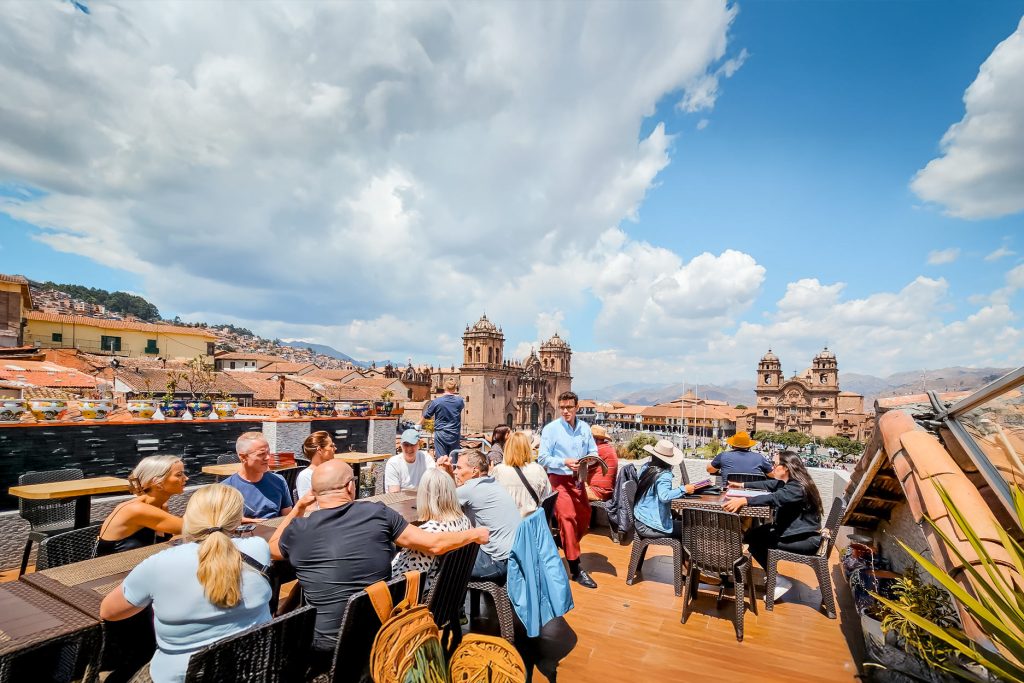
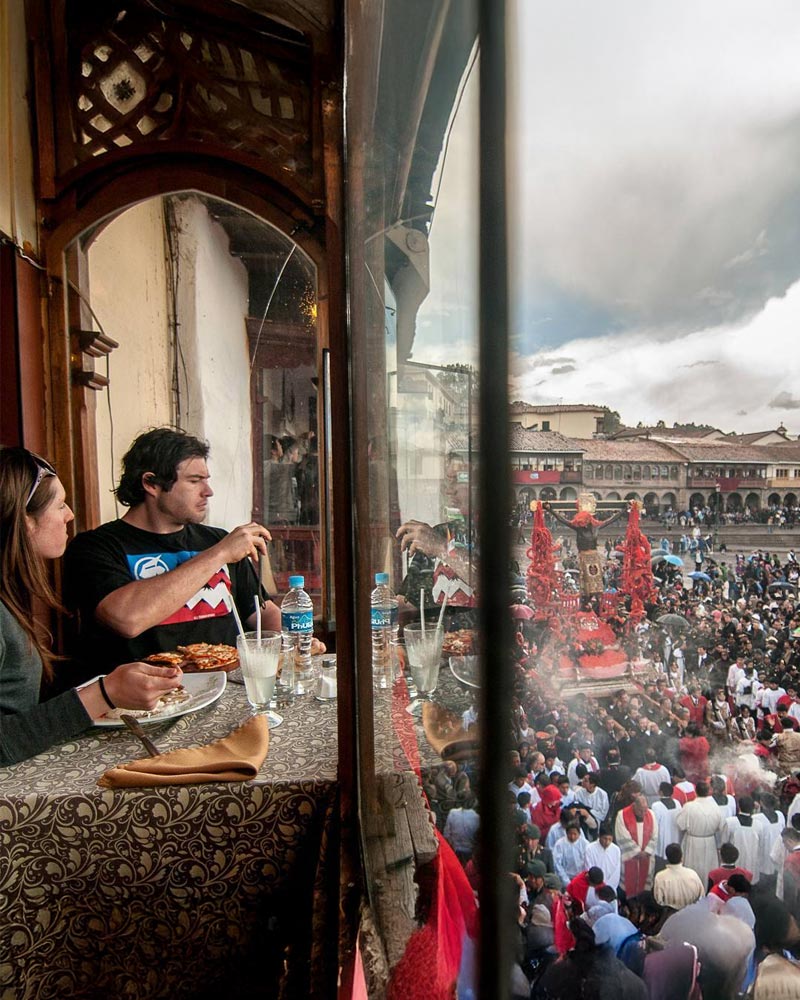
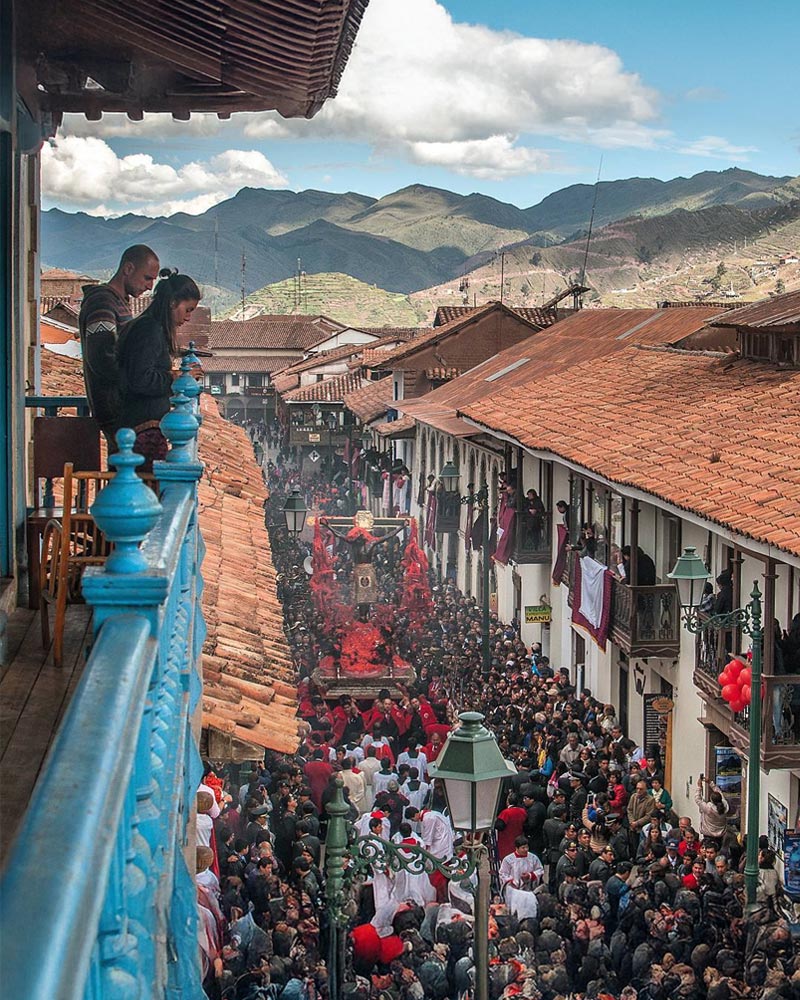
Must-Have Rituals
- Quechua Masses: Starting at 5 a.m., the ch’ayñas (traditional female singers) chant ancient hymns, which are recognized as national cultural heritage.
- Three Blessings: At the end, the Dark-skinned Christ blesses the crowd from the Cathedral’s atrium, under the moonlight and the watchful gaze of the Apu Pachatusan (“Apu” Refers to a sacred mountain spirit in Andean cosmology).
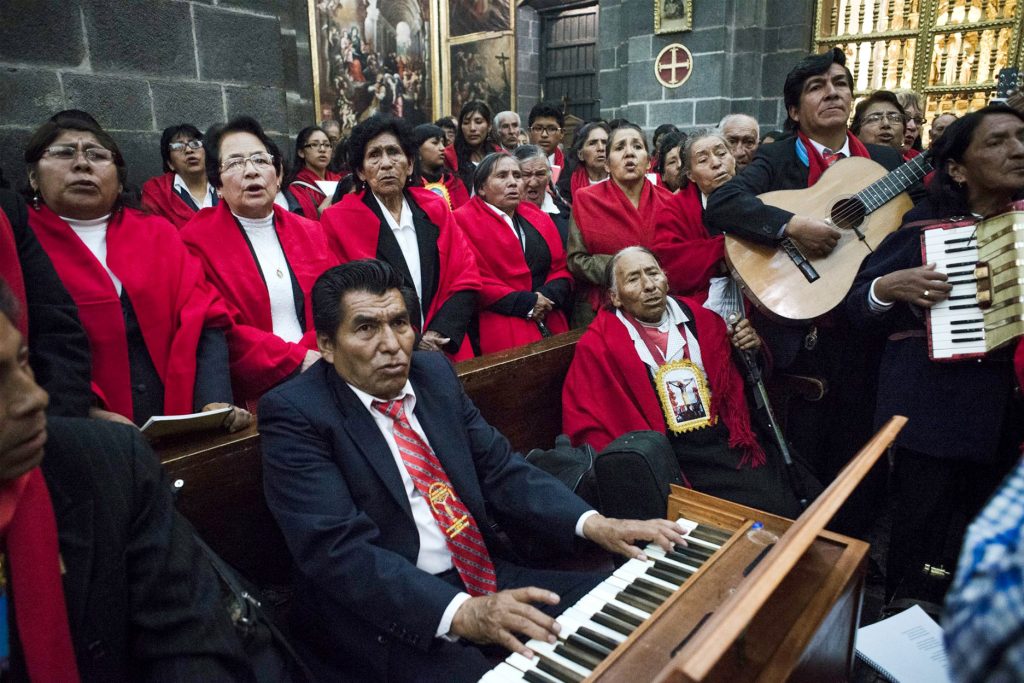
Why is the “Taytacha de los Temblores” So Special?
- Sacred Syncretism: A powerful fusion of Catholic devotion and ancient Andean spirituality.
- Protector Against Disasters: Revered by locals as a divine shield against earthquakes and calamities.
- A Must-See Spiritual Spectacle: One of Peru’s most iconic Holy Week celebrations, famed for its deep passion and breathtaking visuals.
Insider Tips to Live This Unforgettable Experience
- Timing is Everything: The procession starts at 2 p.m., but devoted locals begin securing their spots at the Cusco Cathedral as early as 3 a.m.
- Arrive Early: Cusco’s Plaza de Armas fills up fast; secure your vantage point before the crowds pour in.
- Dress with Reverence: This is a sacred event. Opt for modest, respectful attire to honor local traditions.
- Savor the Sacred Flavors: Indulge in the legendary “12 Platos,” a symbolic feast prepared in honor of Christ’s Passion.
- Travel Light: While Cusco is incredibly safe, crowded events call for extra caution; leave valuables behind.
- Layer Up: April nights in the Andes are chilly. Bring a warm jacket to stay comfortable.
- Honor the Rituals: If you participate, do so with solemnity. For the people of Cusco, this procession is a sacred vow, a testament to faith and resilience.
¡Vive la Magia del Lunes Santo en Cusco!
If you crave an unforgettable journey through spirituality, history, and living culture, you must witness the legendary “Taytacha de los Temblores” procession.
This isn’t just a tradition; it’s the beating heart of Cusco, a sacred spectacle that draws souls from across the globe.

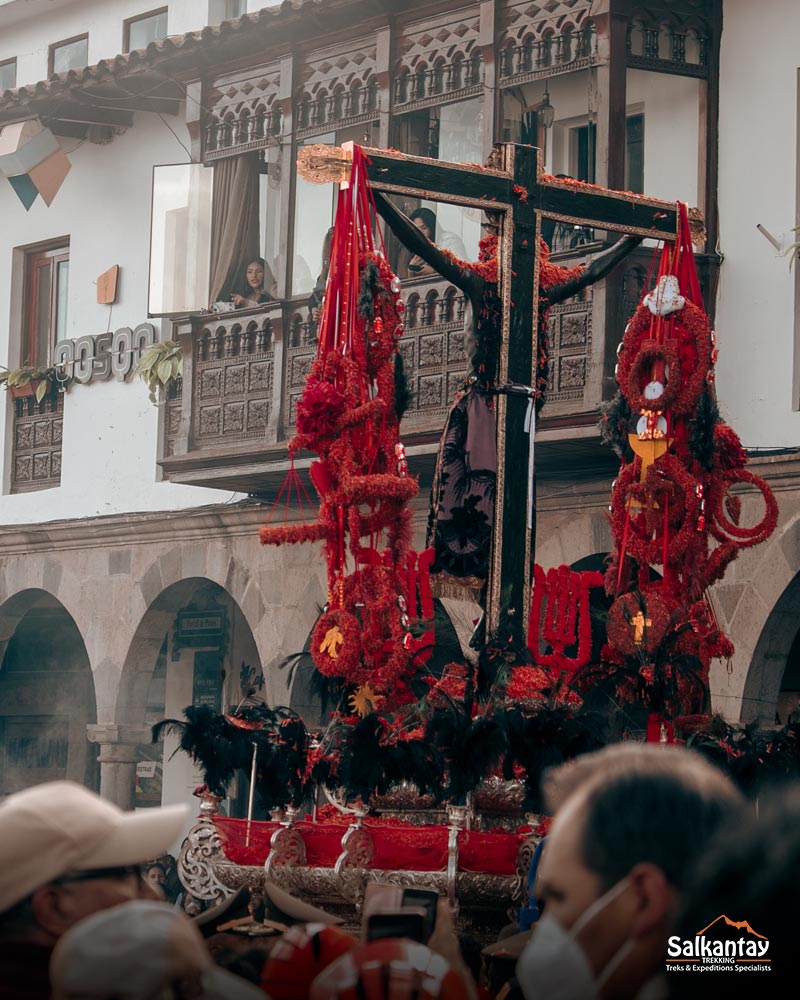
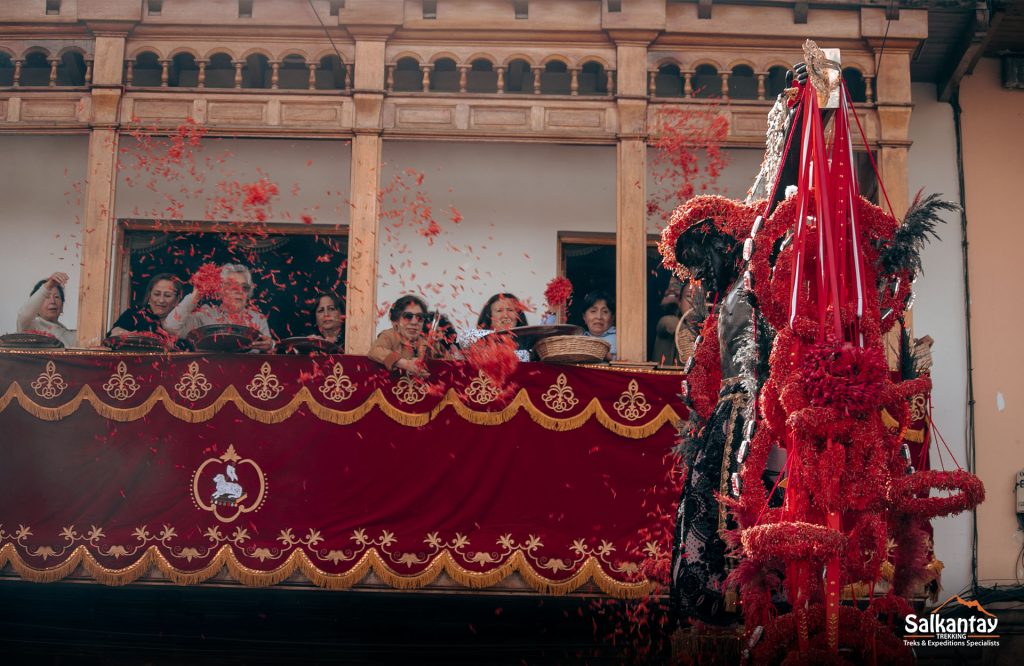
Holy Thursday: Where Faith & Ancient Traditions Collide in the Heart of the Andes
2025 Date: April 17
Holy Thursday in Cusco transcends religion. It’s a seismic collision of faith and culture where the Andes pulse with living history: imagine solemn processions weaving through flower-carpeted streets, 16th-century Last Supper reenactments that blur time, and a spiritual electricity so potent it redefines “sacred travel.” This is where discerning travelers trade sightseeing for soul-stirring encounters with unfiltered Andean devotion.
Procession of the Holy Sacrament: Authorities and Community in Sacred Unity
In Cusco, Holy Thursday comes alive with the iconic Procession of the Holy Sacrament, a profound tradition in which the city’s highest authorities, including the mayor and prefect, lead the march in a powerful display of faith, reverence, and unity. This centuries-old ritual beautifully blends civil and religious devotion, symbolizing the deep connection between the people and their leaders through shared Christian faith.
As the procession unfolds, every church in the city opens its doors, hosting special Masses that transform the streets into a sensory tapestry of hymns, incense, and prayer. Among the most revered sanctuaries welcoming devotees are:
Timing: At dusk (between 5:00 PM and 7:00 PM).
Key Landmarks:
- Cusco Cathedral (a masterpiece of colonial architecture).
- Church of La Compañía de Jesús (the crown jewel of Andean Baroque).
- San Francisco Church (a spiritual and historical treasure).
The Washing of the Feet: A Ceremony of Humility & Sacred Service
One of Cusco’s most moving Holy Thursday traditions is the Washing of the Feet. This powerful reenactment, led by the city’s bishop, echos Christ’s act of humility toward His disciples. Once performed with twelve beggars, today, this sacred ritual honors twelve elders, embodying the eternal Christian values of service, compassion, and unconditional love.
Held in the majestic Cusco Cathedral, this profoundly emotional ceremony draws hundreds of devoted faithful, all seeking to witness a moment of spiritual purification and profound solidarity.
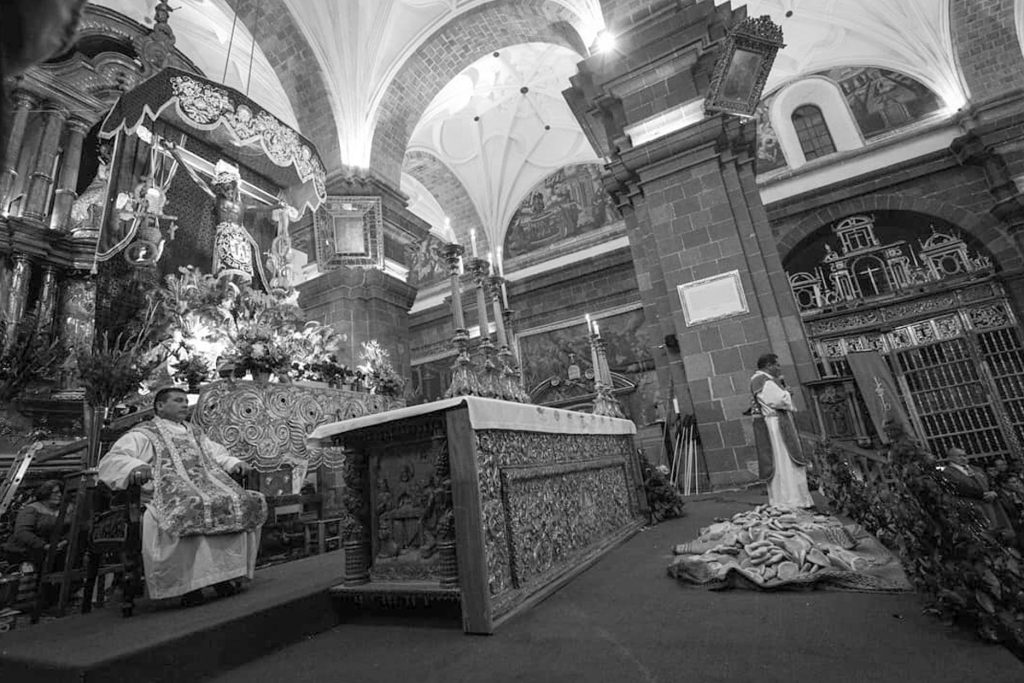
The Seven Churches Pilgrimage: A Mystical Night of Faith & Heritage.
As darkness falls on Holy Thursday, Cusco transforms into a living tapestry of devotion with the Seven Churches Pilgrimage, a profound tradition where locals retrace Christ’s final steps before crucifixion. This profoundly spiritual journey weaves through the city’s most sacred temples, each stop inviting pilgrims to meditate on the Stations of the Cross amidst flickering candles, fragrant flowers, and hauntingly beautiful “Altars of Sorrow” adorned with Passion scenes.
Must-Visit Churches on This Sacred Route:
Pilgrims and travelers alike flock to these iconic sacred sites, including:
- Cusco Cathedral (Main Square) – A colonial masterpiece
- La Compañía de Jesús (Main Square) – Andean Baroque splendor
- San Francisco Church (San Francisco Square)
- La Merced Church (Calle Mantas) – Hidden gem
- Santa Clara Church (Calle Santa Clara)
- San Pedro Church (San Pedro Market) – Local devotion
- San Blas Church (San Blas Quarter) – Bohemian charm
Rigid routes don’t bind this sacred journey; many pilgrims weave their spiritual paths in hidden chapels and lesser-known sanctuaries. As night falls, Cusco’s churches open their doors for quiet prayer and contemplation while the streets hum with devotion under a blanket of stars.
More than just an act of faith, this pilgrimage is a living museum of art and history where soaring colonial altars stand atop ancient Inca foundations, telling layered stories of cultural fusion.
Tips
- Start early – Some churches close by 10 p.m.
- Layer up! – Cusco’s alpine nights bring chilly winds.
- Taste tradition – Don’t miss Holy Week specialties like Friday Soup or the symbolic 12-Dish Feast.
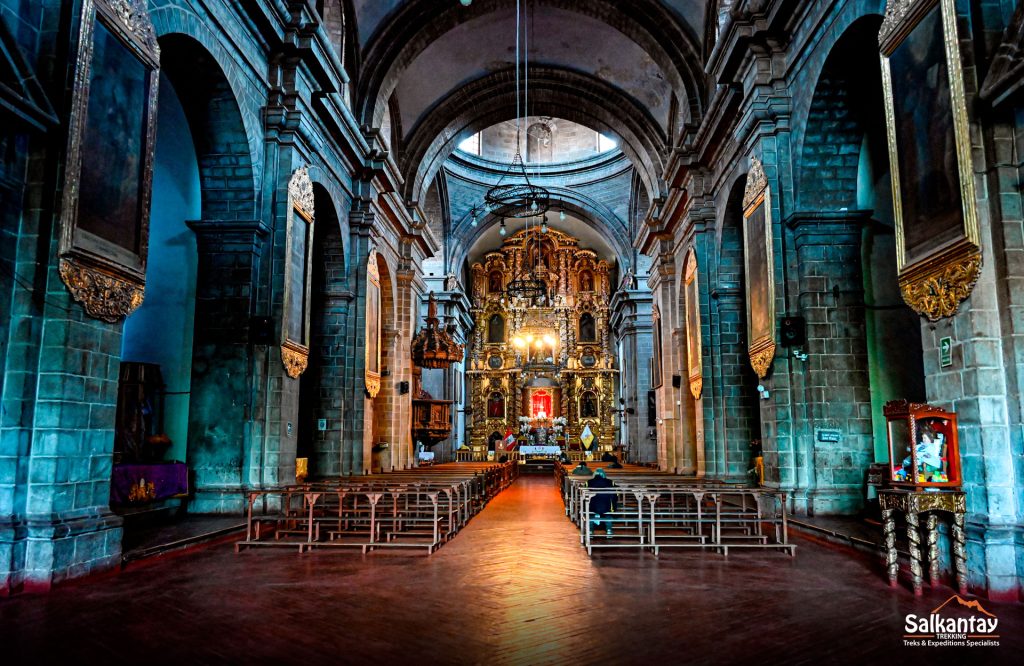
Good Friday 2025: Sacred Journeys & Flavors of Faith.
April 18, 2025 – A day of profound devotion in Cusco
Dawn Pilgrimage: The Stations of the Cross at Sacsayhuamán
Thousands ascend Sapantiana Hill to the Pope’s Cross, retracing Christ’s steps to Calvary in a breathtaking open-air ritual..
After Thursday’s 12-dish feast and Seven Churches Pilgrimage, locals prepare for one of Holy Week’s most moving traditions: the midnight Via Crucis.
“The Holy Vigil” (3:30–4:00 AM): Waves of devotees depart from:
- San Francisco Church (toward Sacsayhuamán)
- La Almudena Church (route to Viva el Perú or Muyuc Orqo)
Hidden History: The most authentic processions once began at La Recoleta and San Francisco, led by brotherhoods carrying massive crosses and disciplinas (an act demanding physical endurance and deep faith!).
Traveler’s Essential Tips:
- Battle the cold: Pre-dawn temps are bone-chilling. Layer up with thermal gear + a traditional Cusco poncho!
- Sacred sustenance: Recharge with empanadas de vigilia or hot api from street vendors.
- Local insight: Arrive by 3:00 AM to secure a spot near the Pope’s Cross for sunrise prayers.
Sacred Routes: Where to Experience Cusco’s Moving Via Crucis
| Starting Point | Destination | Time | Unique Feature |
|---|---|---|---|
| San Francisco Church | Sacsayhuamán (Pope’s Cross) | 4:00 AM | Cusco’s oldest route, led by Franciscan brotherhoods, with breathtaking city views |
| La Almudena Church | Viva el Perú / Muyuc Orqo | 3:30 AM | A challenging pilgrimage favored by devoted locals. |
| San Sebastián Parishes | Alto Qosqo | Before dawn | Family tradition blends Andean offerings with those of the Catholic faith. |
Sacred Gastronomy: The 12 Dishes of Holy Week
After fasting and reflection, Cusco families gather around tables that recreate the Last Supper through 12 symbolic dishes, one for each apostle. This tradition is where Andean flavors meet Catholic tradition in a feast for both soul and palate.
The Sacred Rules of the Table:
- No red meat: In observance of Lent, only fish, seafood, and vegetables grace the table.
- Perfect harmony: 3 soups + 4 main dishes + 5 desserts (with regional family variations).
The 12 Must-Try Dishes
| Type | Dish | Curiosities |
|---|---|---|
| Soups | 1. Lawa (corn cream soup) | Maize base with huacatay (Black mint). |
| 2. Pumpkin soup | Melted Andean quesillo cheese. | |
| 3. Chupe de camarones/machas | Features the most sought-after Lenten ingredients. | |
| Main Dishes | 4. Ceviche | Peru’s flagship dish is fresh and zesty. |
| 5. Fried trout with rice | River fish from the Andes. | |
| 6. Tuna stir-fry | Coastal-meets-highland flavors. | |
| 7. Pumpkin & tarwi stew | Packed with protein from “Andean soy,” | |
| Desserts | 8. Mazamorra de chancaca | Sweetened with sugarcane honey. |
| 9. Cinnamon rice pudding | Creamy, with whole cinnamon sticks. | |
| 10. Peach & apple compote | This sweet tradition thrives in the Sacred Valley, where artisans craft honeyed delights using centuries-old methods. | |
| 11. Cusco-style empanadas | Colonial cloister delicacies. | |
| 12. Suspiro (meringues) | Light as a “sigh” (their name’s meaning!). | |
| 13. Jurka bread/cake | Wood-fired oven goodness. | |
| 14. Maicillos | Crispy toasted corn cookies. |
*Some families mix & match soups, mains, or desserts, but the total must always be 12, honoring the Apostles.
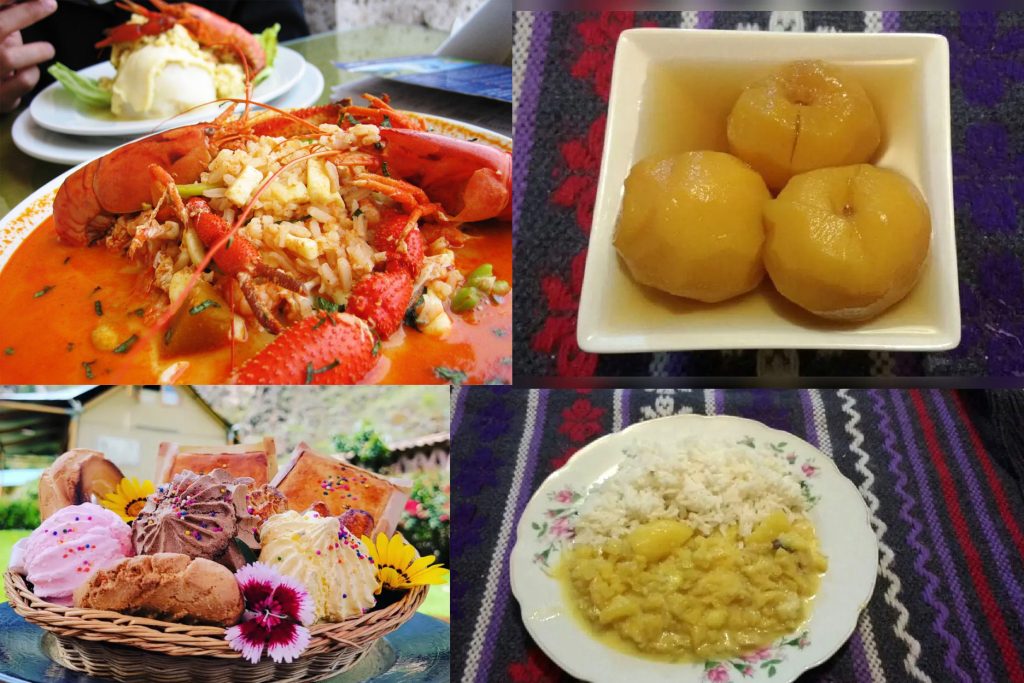
How This Tradition Comes to Life
- Generational kitchens: Families take turns preparing the 12 dishes, with grandmothers reigning as recipe guardians.
- Open-table spirit: Neighbors and travelers are welcome to share this symbolic meal (because faith tastes better together).
- Andean soul: Many add cochayuyo (seaweed) or rocoto pepper for an unmistakable Cusqueño twist.
Good Friday Procession:
Each Good Friday, Cusco’s streets become a living canvas of sorrow and glory with three sacred icons:
- Our Lady of Sorrows – A heart-wrenching depiction of a mother’s grief.
- The Holy Sepulchre – Christ’s tomb, carried in solemn silence.
- The Relic of the True Cross – A venerated splinter from Jesus’s cross, radiating centuries of faith.
This isn’t just a procession; it’s where Catholic fervor and Inca heritage collide under the Andean sky.
Hampi Rantikuy: The Healing Market. At San Francisco Square, discover stalls selling:
- Thorn crosses (for home protection)
- Sacred herbs (for purification baths). Think of it as Andean aromatherapy meets spirituality.
Tip: Try the “full menu”: Upscale spots like Cicciolina or Chicha (by Gastón Acurio) offer curated 12-dish tastings.
Come hungry: Portions are family-sized—fasting beforehand is strategic.
Collect recipes: Many families share them as acts of grace (ask politely!).
Holy Saturday in Cusco: A Night of Fire, Faith, and & Rebirth
April 19, 2025
1. The Easter Vigil: Cusco’s Most Sacred Night
- When: 8:00 PM – Midnight
- Where:
- Cusco Cathedral (Plaza de Armas) – The epicenter of devotion
- La Compañía de Jesús – Baroque Splendor Meets Resurrection Joy
- San Francisco Church – Where history and faith intertwine
- The Magic Moments You Can’t Miss:
- Blessing of the New Fire: A priest lights the Paschal Candle, symbolizing the risen Christ as thousands of candles ignite in unison, painting the night in gold.
- “Gloria!” Resounds: After days of silence, church bells crash triumphantly into the Andean sky, announcing: “He is risen!”
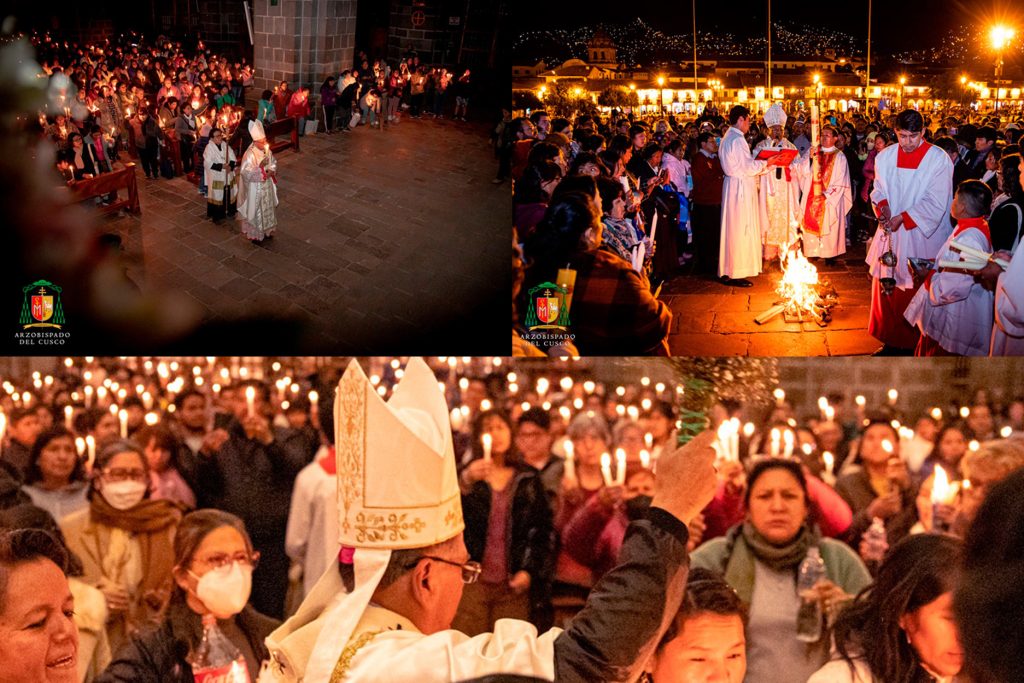
Easter Sunday in Cusco: The Grand Celebration of Life
April 20, 2025
Easter Sunday in Cusco is Holy Week’s most vibrant and jubilant day. After the solemn introspection of the preceding days, the city erupts in a dazzling celebration of Christ’s Resurrection, where Catholic grandeur meets ancient Andean renewal traditions. A symphony of music, color, and unbridled joy transforms Cusco into a living tapestry of faith and cultural heritage.
Easter Sunday Traditions in Cusco
1. Sunrise Easter Mass
Time: 5:00 AM – 7:00 AM (symbolizing the moment the women discovered the empty tomb).
Key Locations:
- Cusco Cathedral (Plaza de Armas)
- Church of La Compañía de Jesús
- Santo Domingo (Koricancha)
Most Emotional Moment:
- The triumphant proclamation of “Christ is risen!” is followed by the jubilant ringing of bells.
- Burning of incense and flowers in honor of renewed life.
2. Procession of the Risen Lord
Time: 10:00 AM (approximately)
Route: The image of the Risen Christ departs from the Cathedral and parades through the historic center, accompanied by live bands, traditional dancers, and devotees carrying flowers.
3. Festivals & Fairs
The Gastronomic Fair invites visitors to feast on iconic dishes like lechón al horno (roast suckling pig) and savor artisanal sweets.
Music & Dance: Folkloric groups perform huaynos (traditional Andean folk music and dance) and comparsas in plazas like San Francisco and San Pedro.
Pascal Feast: Traditional Easter Cuisine
After Lent, Cusco families gather for a lavish banquet:
- Roast suckling pig or lamb (forbidden on Good Friday).
- Cusco-style tamales (stuffed with spiced meat).
- Anise-infused rosquillas & bizcochos (sweet breads blessed during Mass).
Easter Sunday in Cusco is a breathtaking explosion of life, tradition, and community an experience you simply cannot miss!
The perfect finale! Easter Sunday is celebrated with joyous Masses and heartwarming family feasts, marking the triumphant close of a week steeped in profound spirituality. Immerse yourself in the Greatest Celebration of Faith in the Capital of the Inca Empire!
Why is Cusco the Ultimate Destination for Holy Week?
- Unique Syncretism: Cusco is a place where deep-rooted Catholicism beamlessly blends with ancient Inca traditions, creating a unique cultural experience that you won’t find anywhere else
- Cusco’s faithful parade awe-inspiring, centuries-old sacred statues through flower-strewn streets in a vibrant display of undying devotion.
- Sacred Gastronomy: Indulge in exquisite seasonal flavors you won’t find any other time of year.
- Living Culture: From stunning floral carpets to time-honored ancestral fairs, every moment is a vibrant spectacle.
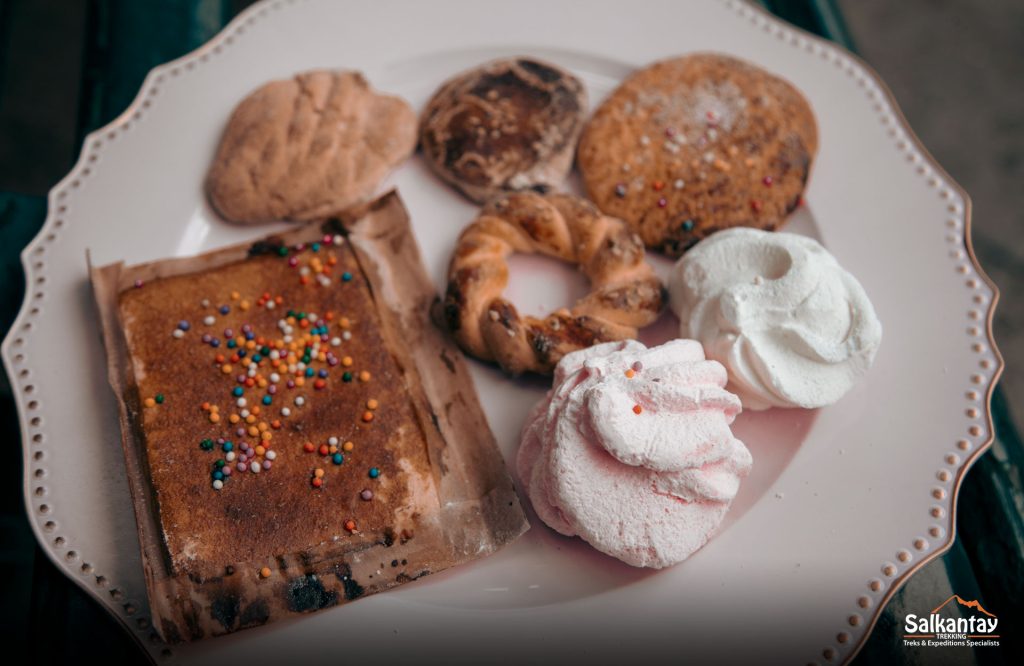
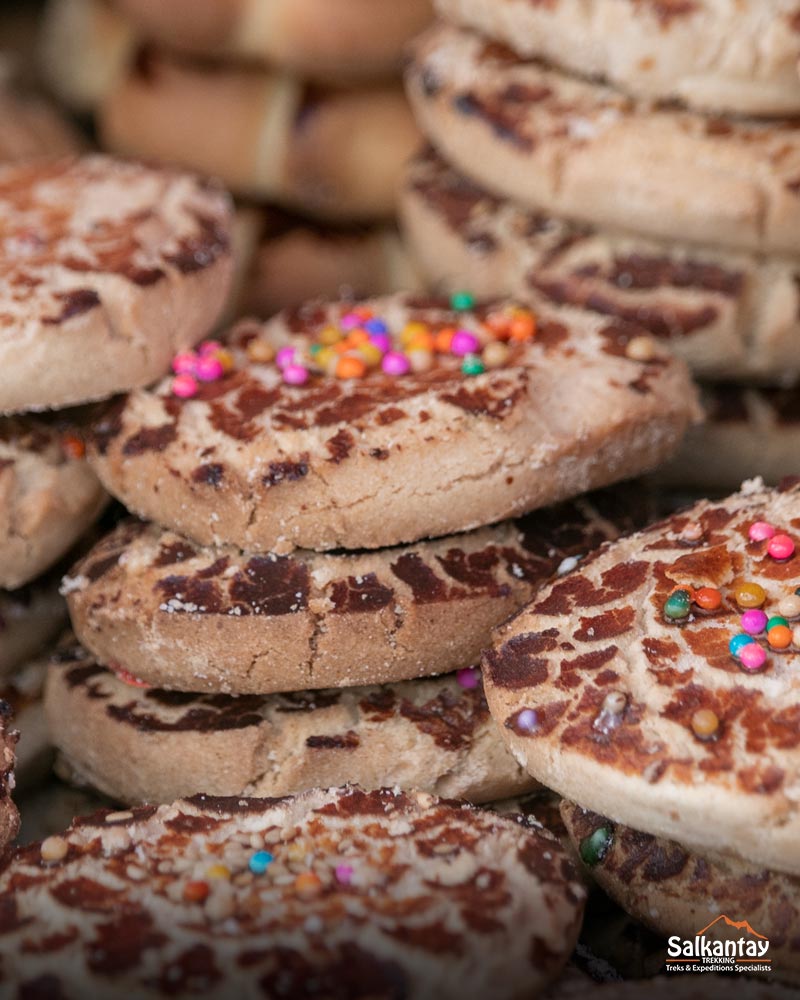
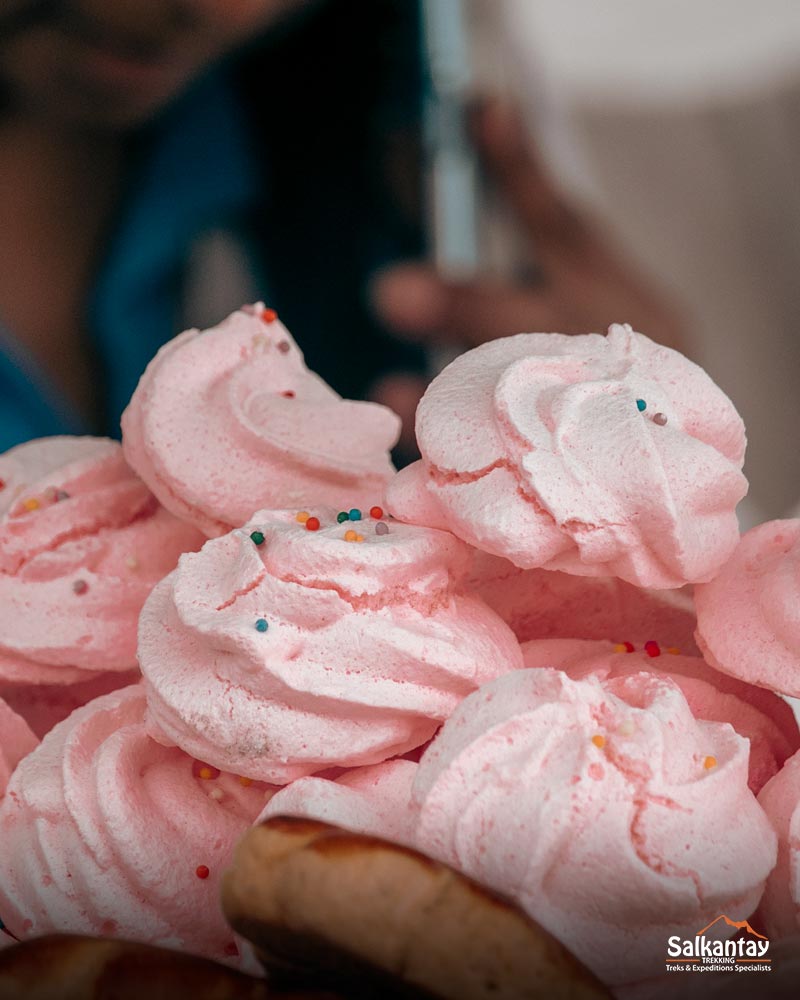
Did You Know? The Señor de los Temblores (Lord of the Earthquakes) is the only religious icon in Peru insured for millions of dollars. Its historical value is genuinely priceless!
Conclusion:
Cusco will leave you breathless with its one-of-a-kind traditions, where devotion, culture, and mysticism collide in the most mesmerizing way. Holy Week in Cusco is an unforgettable experience, blending vibrant processions, ancient rituals, and sacred flavors that transport you to a world of deep spirituality and Andean beauty.
Ready for an adventure? Immerse yourself in this magical celebration or explore Cusco’s hidden treasures with our ultimate tours, which include epic treks through jaw-dropping landscapes, guided journeys to legendary archaeological sites, and custom experiences uncovering the soul of this fabulous region.
Cusco is calling you! With open arms and a unique adventure for every traveler, this is your moment to discover the extraordinary!

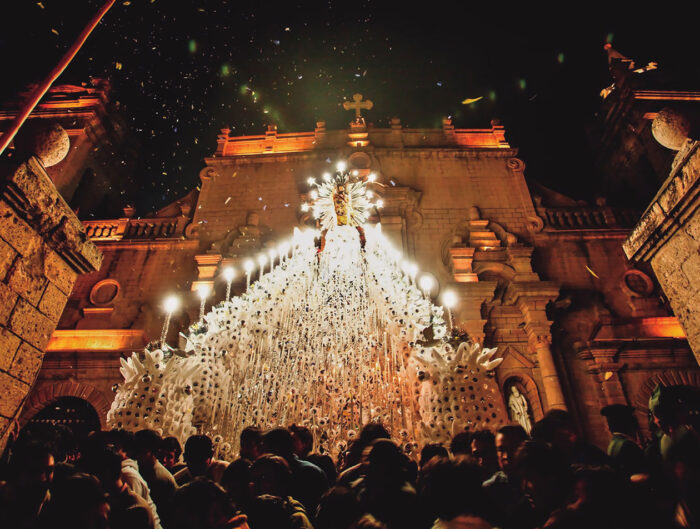
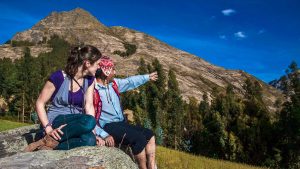

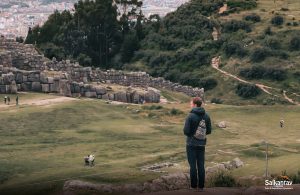
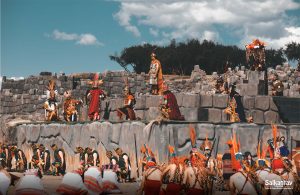
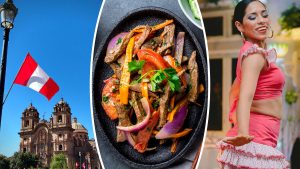

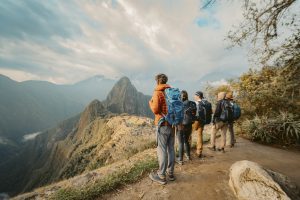



Leave A Reply